Unused doors can be unsightly, disrupt room layouts, or even create security concerns within a home. They may lead to awkward spaces that are difficult to furnish or decorate around, interrupting the flow and harmony of a room. Homeowners can improve aesthetics and functionality by learning how to hide an unused door.
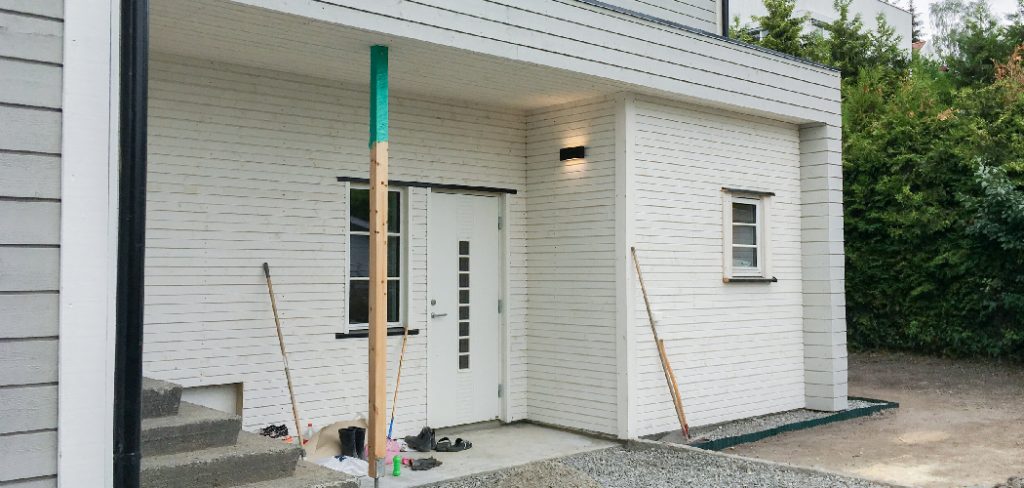
Concealing an unused door enhances room design by eliminating visual distractions and promoting a seamless appearance. It also helps increase security by removing potential weak points in the architecture. Furthermore, sealing off unused openings can contribute to energy efficiency, reducing drafts and temperature variations.
This article aims to provide readers with practical methods and creative ideas for effectively hiding or disguising an unused door. From simple DIY fixes to professional solutions, there are numerous options to ensure that an unused door integrates harmoniously into your living space.
Assessing the Door and Room Layout
Identify the Type of Door
Understanding the type of door you have is critical before embarking on a concealment project. Begin by determining if the door is a traditional hinged, sliding, or pocket door. A traditional hinged door is typically easier to conceal, as it swings on a set of hinges and can be covered with bookcases or panels.
Sliding and pocket doors may pose a unique challenge, as they require different mechanisms that allow for their respective movements, which could complicate the concealment process.

Evaluate the Room Layout
The next important step is to evaluate the room’s layout and how the door fits within this space. Consider the door’s position in relation to existing furniture, wall space, and the room’s overall design. A door located in a prominent position might require a more carefully planned disguise to ensure that it doesn’t interrupt the aesthetic flow of the room. Additionally, limited wall space might restrict options for concealing an unused door, suggesting a need for more inventive solutions.
Determine the Door’s Purpose
Lastly, consider the door’s future use. Determine if it needs to remain accessible or if it is entirely redundant. If the door may need to be accessed in the future for occasional use, choose a concealment method that allows easy access, such as hidden panels or curtains.
However, if the door is completely unnecessary, more permanent solutions can be considered, like converting it into a decorative feature or storage space. This determination will guide the choice of concealment methods most appropriate for your needs.
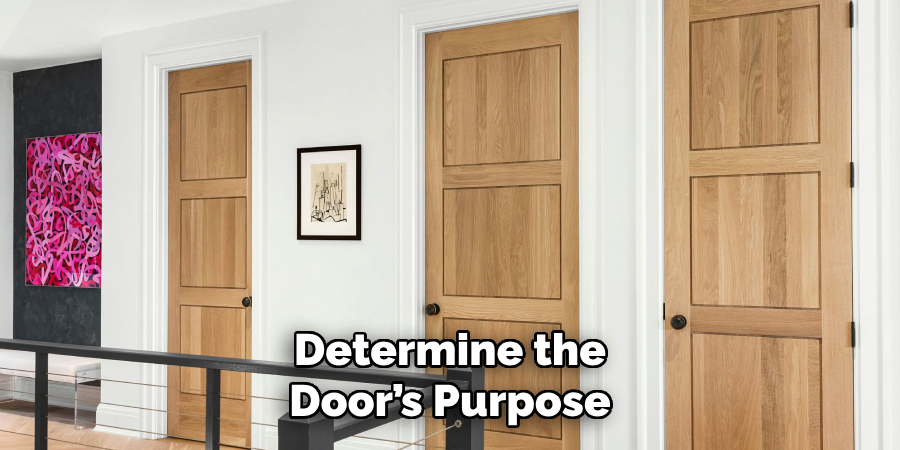
How to Hide an Unused Door: Concealing the Door with Panels or Bookcases
A. Using a Panel or Wainscoting
Step 1: Measure and Cut Panels:
Begin by measuring the dimensions of the unused door. Use these precise measurements to cut panels or wainscoting that will fit seamlessly over the door. Ensure the cuts are accurate to achieve a clean and professional look once installed.
Step 2: Attach Panels:
Position the panels or wainscoting cut to size over the door. Secure the panels to the wall around the door using either strong adhesive or screws. Ensure the attachment is flush with the wall to maintain a smooth, continuous surface. This step is crucial for creating a seamless appearance that doesn’t reveal the door’s outline.
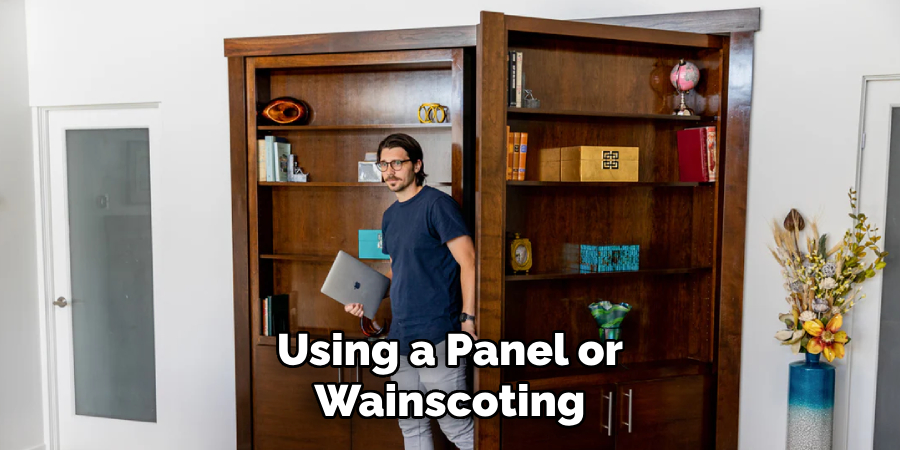
Step 3: Finish the Paneling:
To ensure the paneling or wainscoting blends with the room’s aesthetics, paint or stain the panels to match the existing wall color and finish. Pay attention to detail in painting or staining to maintain uniformity, which will help in effectively disguising the door.
B. Building a Bookcase or Shelving Unit
Step 1: Design the Bookcase:
Measure the door to understand its dimensions, and consider designing a bookcase or shelving unit that will completely cover it. It’s important that the design not only hides the door but also complements the room’s overall style. Assess the potential for storage and decorative functionality, ensuring the unit offers both style and practicality.
Step 2: Construct or Purchase a Bookcase:
Decide whether to build a custom bookcase for your space or purchase a pre-made unit that fits your needs. If you build the bookcase, select sturdy materials and design it to precisely accommodate the door’s dimensions. Construction should prioritize durability and stability to safely serve as both a concealment method and a storage solution.
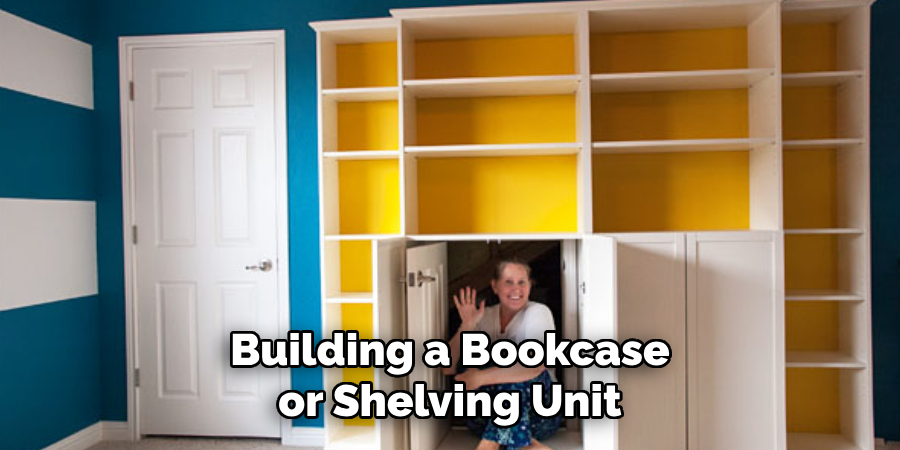
Step 3: Install the Bookcase:
Once your bookcase is ready, place it in front of the door. To ensure safety, secure the bookcase to the wall to prevent any risk of tipping. Use brackets or wall anchors for added stability, especially in households with children or pets, where the risk of movement might be higher.
Step 4: Decorate the Bookcase:
With structural elements in place, focus on decorating the bookcase. Arrange books, decorative items, or personal mementos in a way that naturally blends the unit into the room’s decor. This step hides the unused door and adds a personalized touch to your living space, enhancing the room’s overall aesthetic appeal.
How to Hide an Unused Door: Creating a Faux Wall or Hidden Door Panel
A. Building a Faux Wall
Step 1: Frame the Area:
Construct a frame around the door opening using wood or metal studs, creating a new wall section that fits snugly within the existing space. Precision in measuring and cutting is crucial to ensure a solid foundation for the faux wall.
Step 2: Attach Drywall or Paneling:
Secure drywall or alternative wall materials to the frame. Finish the installation with a joint compound to smooth the surface and prepare it for painting, ensuring edges are well-seamed for a cohesive look.
Step 3: Paint and Finish:
Paint the new wall section to blend seamlessly with the rest of the room. Choose a color and finish that matches the existing walls to maintain a uniform appearance, making the faux wall indistinguishable from the original structure.
B. Installing a Hidden Door Panel
Step 1: Design the Panel:
Create a panel that matches the surrounding wall. Utilize materials like wallpaper or a paint finish that complements the existing decor, ensuring that the panel’s design integrates seamlessly with the room environment.
Step 2: Attach the Panel:
Secure the panel over the door using adhesive or screws. The attachment should be flush with the surrounding wall to avoid noticeable seams, contributing to the panel’s hidden nature.
Step 3: Complete the Look:
Ensure the hidden door panel blends well with the room’s decor. This involves synchronizing colors, textures, and patterns, allowing the panel to disappear into the wall and creating a smooth, concealed appearance that enhances the room’s overall aesthetic.
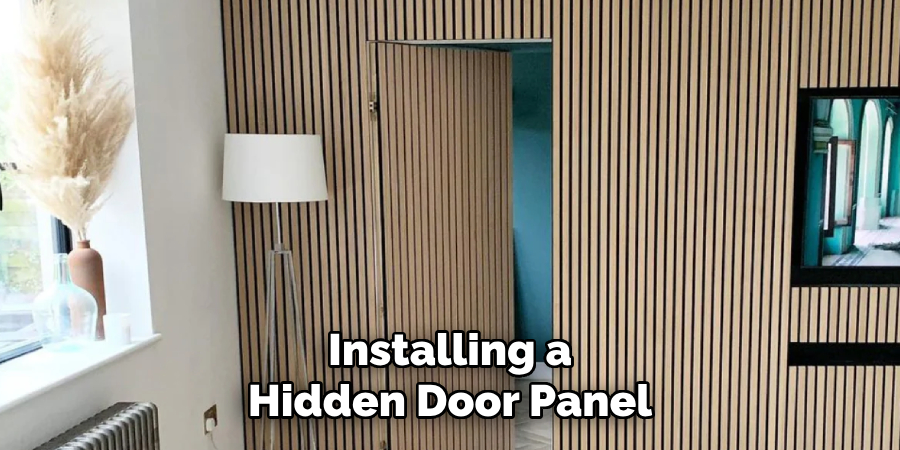
Using Fabric or Curtains
A. Hanging a Decorative Curtain
Step 1: Choose a Curtain:
Select a curtain or fabric that complements the room’s decor. This could be a solid color that highlights other elements in the space or a patterned design that adds visual interest.
Step 2: Install a Curtain Rod:
Mount a curtain rod above the door, ensuring it extends slightly beyond the doorframe. This allows the curtain to fully obscure the door while blending seamlessly into the rest of the room.
Step 3: Hang the Curtain:
Hang the curtain and adjust it to cover the entire door area. This creates a soft, decorative cover that enhances the room’s aesthetic while hiding the door effectively.
B. Using a Sliding Fabric Panel
Step 1: Measure and Cut Fabric:
Measure the door and cut the fabric to fit, allowing for overlap around the edges. This ensures that the door is completely covered when the panel is in place.
Step 2: Install a Sliding Track:
Install a sliding track above the door. This track should be securely mounted, allowing the fabric panel to slide smoothly.
Step 3: Attach the Fabric:
Attach the fabric to the sliding track, allowing it to open and close to cover the door. This provides a flexible and stylish solution, offering both concealment and easy access as needed.
Repurposing the Door
A. Transforming the Door into a Functional Feature
Step 1: Convert to a Built-In Cabinet:
Consider adding shelves or cabinetry to transform the door into a practical storage solution. This involves securing shelving units directly onto the door, effectively utilizing the space for storing books, toiletries, or household items. Ensure the converted cabinet blends seamlessly with the room’s style, maintaining both functionality and aesthetic appeal.
Step 2: Create a Display Area:
Transform the door into a showcase for visual interest by turning it into a display area for artwork, photos, or decorative pieces. This can involve installing frames or ledges onto the door surface, creating a dynamic focal point in the room that serves both decorative and functional purposes.
B. Turning the Door into a Piece of Art
Step 1: Paint or Decorate:
Personalize the door by painting or decorating it to complement or contrast with the room’s existing decor. Choose colors and patterns that enhance the room’s character, potentially turning the door into a vibrant piece of art that captures attention and adds to the interior design.
Step 2: Mount as a Feature Piece:
Once decorated, the door can be mounted on a wall or framed to serve as a significant focal point. Position the door in a prominent location where its artistic transformation can be fully appreciated, making it a remnant of architectural function and a centerpiece of creativity within the space.
Professional Solutions for Concealing Doors
Hiring a Contractor or Designer
For those seeking a polished finish, engaging the services of a contractor or interior designer can ensure a seamless integration of the hidden door with your existing space. Professionals bring a wealth of experience and creativity to the table, transforming your vision into reality with precision.
Custom Solutions
One of the benefits of opting for professionals is access to bespoke solutions that cater specifically to your needs. Whether it’s custom-built cabinetry that utilizes every inch of space efficiently or elegant paneling that adds a touch of sophistication, the customization options are virtually limitless.
Cost Considerations
While professional services can provide high-quality results, it’s essential to consider the associated costs. Prices can vary based on materials, complexity, and labor, so comparing these with DIY approaches is crucial. Ultimately, weighing the investment against the potential for a flawless finish will help determine the best route for your project.
Maintenance and Future Considerations
Maintaining Concealed Doors
Ensuring the longevity of concealed doors requires regular maintenance. Check that all coverings or panels are securely attached and free from damage or wear. Regular inspections can prevent issues such as loose fittings or fabric fraying, which could compromise the appearance and functionality.
Accessing the Door in the Future
While the primary goal is to conceal the door, it’s important to maintain easy accessibility. Consider how the coverings can be removed or adjusted with minimal effort. This might involve choosing attachment methods that allow for easy dismantling or adjustments, ensuring the door can be accessed quickly when needed.
Updating the Concealment
Be prepared to adapt the concealment technique as your room’s design or functional requirements evolve over time. This could mean periodically refreshing the panel’s color or fabric or even switching to a different method altogether to suit new design themes or purposes within the space.
Conclusion
In this guide on how to hide an unused door, we explored various innovative concealment methods to match your style and needs. Panels provide a sleek look, offering a clean finish, while transforming the door into a bookcase utilizes space effectively for storage. Faux walls offer complete integration into the room, creating a seamless look. Fabric options bring softness and adaptability, and repurposing as artwork or functional features adds creativity and functionality.
When choosing the right method, consider your room layout, aesthetic preferences, and functional requirements. Whether opting for a simple DIY approach or seeking professional assistance, concealing an unused door elevates your space’s aesthetic and optimizes its utility. Ultimately, the chosen technique should enhance the overall ambiance and efficiency, turning an unused door into an asset rather than an obstacle.
About
Safety Fic is a distinguished figure in the world of Diy design, with a decade of expertise creating innovative and sustainable Diy solutions. His professional focus lies in merging traditional craftsmanship with modern manufacturing techniques, fostering designs that are both practical and environmentally conscious. As the author of diy, Safety Fic delves into the art and science of Safety Fic-making, inspiring artisans and industry professionals alike.
Education RMIT University
(Melbourne, Australia) Associate Degree in Design (Safety Fic) Focus on sustainable design, industry-driven projects, and practical craftsmanship. Gained hands-on experience with traditional and digital manufacturing tools, such as CAD and CNC software.
Nottingham Trent University
(United Kingdom) Bachelor’s in diyfastly.com and Product Design (Honors) Specialized in product design with a focus on blending creativity with production techniques. Participated in industry projects, working with companies like John Lewis and Vitsoe to gain real-world insights.
Publications and Impact
In diy, Safety Fic his insights on indoor design processes, materials, and strategies for efficient production. His writing bridges the gap between artisan knowledge and modern industry needs, making it a must-read for both budding designers and seasoned professionals.
